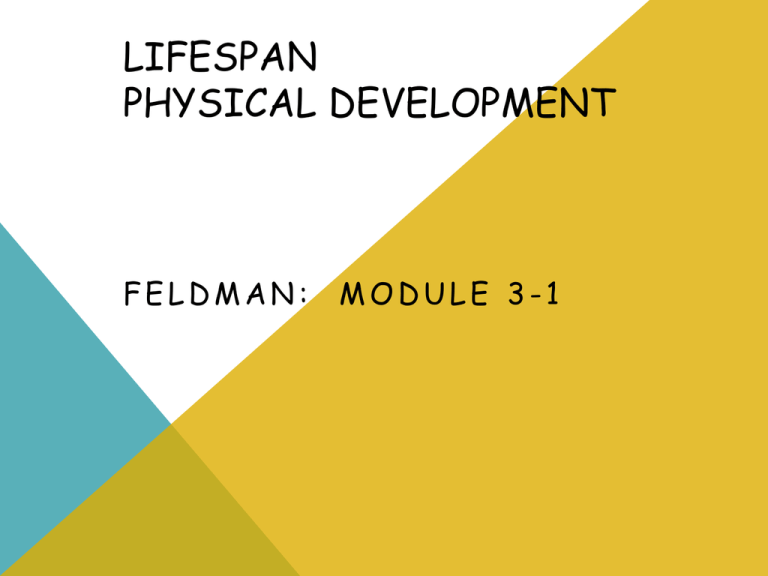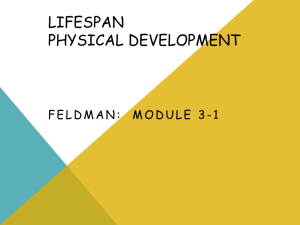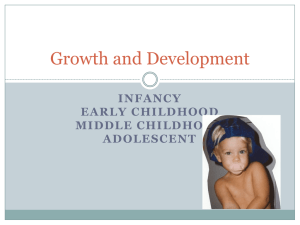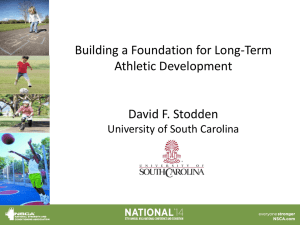
LIFESPAN
PHYSICAL DEVELOPMENT
FELDMAN:
MODULE 3-1
MOTOR DEVELOPMENT
.Gross motor development involves large muscle groups and activities that
generally have to do with locomotion
Fine motor development involves smaller muscle groups and activities such as
reaching and grasping
PERSPECTIVES ON MOTOR
DEVELOPMENT
Nature-focused view:
Developmental maturation
Nurture-focused view:
Dynamic systems theory: the child develops new motor skills by adapting and
adding to old ones to meet his/her goals
DYNAMIC SYSTEMS THEORY OF
MOTOR DEVELOPMENT
Mastery of motor skills involves acquiring increasingly complex systems of
action.
Each new skill is a joint product of:
1) Central nervous system development
2) movement capacities of the body
3) goals of the child
4) environmental supports for the skill
NEWBORN REFLEXES
blinking
grasping
rooting
sucking
Babinski
Moro
stepping
swimming
GROSS MOTOR
DEVELOPMENT
Gross motor development follows a generally
universal sequence.
Cephalocaudal and proximodistal trends are evident.
There is no fixed maturational timetable.
AGE NORMS (IN MONTHS) FOR GROSS
MOTOR SKILLS*
ORGANIZED SPORTS IN CHILDHOOD NEGATIVES
Negatives
Too much pressure to perform
Physical injuries
Distraction from academic work
Unrealistic expectations as an athlete
Wrong values
Possible exploitation
GROSS MOTOR - ADULTHOOD
Gross motor skills improve in adolescence
They peak in the 20’s
They decline through the remainder of adulthood
FINE MOTOR SKILLS
SEQUENCE OF GRASPING BEHAVIOR
Newborn grasping reflex
palmar grasp – can be varied
4-5 months, transfer objects from hand to hand
1 year – pincer grasp
(Trying to push infants beyond their readiness
may backfire.)
FINE MOTOR SKILLS INFANCY
Reaching affects cognitive development
because it opens up new ways of exploring
the environment.
Infants use proprioceptive cues to reach as
early as 4 months
FINE MOTOR – EARLY CHILDHOOD
Fine motor progress is apparent in
Children’s care of their own bodies
Drawing and painting
SELF-HELP SKILLS
2-3 years zips, puts on clothes
3-4 years button (large buttons)
5-6 years ties shoes
2-3 years
3-4 years
4-5 years
5-6 years
uses spoon
serves self food
uses fork
uses knife
DRAWING AND PAINTING
3-4 years
copies vertical line/circle
Draws a “tadpole” person
4-5 years
Cuts with scissors
Copies triangle, cross, some letters
5-6 years
Draws person with 6 parts
Copies some numbers, simple words
FINE MOTOR – MIDDLE
CHILDHOOD
Increased myelination of CNS
6-year-olds can hammer, paste, tie shoes, fasten clothes
7 years – use pencil & print smaller
8-10 years – write cursive & use hands independently
12 years – approach adult skill levels
Girls outperform boys
FINE MOTOR – OLDER ADULTHOOD
Slower motor behavior
Neural noise – irregular neural activity in the
CNS
Strategy – may have to slow to perform
accurately
Can learn new motor tasks, but more practice
required
INFLUENCES ON PHYSICAL GROWTH & HEALTH
Genetics
Infectious disease
Childhood injuries
Hormones
Emotional well-being
Nutrition
INFLUENCES ON PHYSICAL GROWTH &
HEALTH - IMMUNIZATION
Immunization has caused a dramatic decline in
childhood diseases in the industrialized world
24% of American preschoolers lack essential
immunizations (40% in poverty)
Availability of care
Misconceptions (MMR & autism)
INFLUENCES ON PHYSICAL GROWTH &
HEALTH – EMOTIONAL WELL BEING
Psychosocial dwarfism
Caused by extreme emotional deprivation
Appears between 2 & 15 years of age
Can interfere with the production of GH
Very short stature
Immature skeletal age
Severe adjustment problems
Can be treated
THE GROWTH SPURT OF PUBERTY
Most rapid growth since infancy
Average of age 9 for girls; 11 for boys
Girls grow 3.5 inches/year; boys 4 inches
50% of body weight gained in adolescence
Also changes in leg length and facial structure
WHY DOES PUBERTY HAPPEN EARLIER THAN IT
USED TO?
Nutrition ? – Better than in earlier times
Hormones ? – Found in food supply
Stress ?
Fat ?
STRESS THEORY OF EARLY PUBERTY
Hypothalamus pituitary sex glands produce
gonadotrophins
Androgens (testosterone)
Estrogens (estradiol)
Pituitary thyroid gland produces growth hormone
Cortisol (stress hormone) may trigger early onset (pituitary
activity)
FAT THEORY OF EARLY PUBERTY
Weight affects the timing of menarche (106 +/- 3
pounds)
Athletes and anorexics become amenorrheic
Fat and leptin may also be influential
ADULTHOOD
NORMAL PHYSICAL DEVELOPMENT:
EARLY & MIDDLE ADULTHOOD
Early Adulthood, peak muscle tone & joint function
Senescence
Middle Adulthood – gradual changes,
lose height, gain weight, in 40s & 50s skin sags,
wrinkles, age spots, hair thins, thicker finger- and
toenails, yellow teeth
CHANGES IN MIDDLE ADULTHOOD (CONT’D)
Sarcopenia – age-related loss of muscle mass &
strength
Lose 1-2% per year starting at age 50
Exercise can help to reduce this loss
Also lose bone from the late 30’s; this accelerates in
the 50’s
CHANGES IN MIDDLE ADULTHOOD
Cholesterol increases
LDL – leads to atherosclerosis
Blood Pressure increases; sharply for women at
menopause
Metabolic disorder – hypertension, obesity, insulin
resistance, high cholesterol, low HDL, weight gain (Part of
normal aging?); weight loss & exercise help
Lungs become less elastic
ADULT HEALTH - REPRODUCTIVE SYSTEM
The 20’s are ideal for reproduction. Risks of miscarriage
and chromosomal disorders are reduced.
First births to women in their 30’s have increased in the
past two decades
Dramatic rise in fertility problems in the mid-thirties (14
to 26%)
CHANGES IN MIDDLE
ADULTHOOD - SEXUALITY
Climacteric – loss of fertility
Menopause – ceasing of menstrual cycles (average
age 52)
Drop in estrogen, hot flashes, nausea, fatigue, rapid
heartbeat
Gradual decline for men (no andropause)
ADULT HEALTH IMMUNE SYSTEM
Capacity declines after age 20, partially due to
thymus and inability to produce mature T cells
Stress and depression can also weaken the
immune system
ADULT HEALTH - STATES OF MIND
Western stereotype: deterioration is inevitable
In one study, people with positive self-perceptions of aging
live 7 ½ years longer
More optimistic elders are about capacity to cope with
physical challenge, better they are at overcoming threats to
health
Low SES elders are less likely to believe they can control their
health, to seek medical treatment, or to follow doctors’
orders.
BIOLOGICAL THEORIES OF AGING
Cellular clock (Hayflick)
70-80 cell divisions, based on telomeres
120-year lifespan
Free-radical
Calorie restriction
antioxidants
Mitochondrial
Cellular energy producers
Linked to free radical theory
Hormonal Stress
hypothalamic-pituitary-adrenal axis
Stress & decline in immune function
SANTROCK: CHAPTER 4
FELDMAN: MODULES 4-1 & 4-2
Injury and Illness through the
Lifespan
CHILDREN
INFLUENCES ON PHYSICAL GROWTH &
HEALTH - IMMUNIZATION
Immunization has caused a dramatic decline in childhood diseases in the industrialized world
24% of American preschoolers lack essential immunizations (40% in poverty)
Availability of care
Misconceptions (MMR & autism)
INFLUENCES ON PHYSICAL GROWTH &
HEALTH – OTITIS MEDIA
70+% of American children have had at least one bout
by age 3
Xylitol may be a preventative
Tubes remain controversial
Child-care settings should control infection
May cause problems in language development due to
hearing problems
ASTHMA
19% of N.A. children have chronic diseases and
conditions
Asthma accounts for 1/3 of chronic illness and is the
most common reason fro school absence
Incidence has increased dramatically, 8% of U.S.
children—boys, low SES, parents smoke, born
underweight most at risk
INJURIES IN EARLY CHILDHOOD
Leading cause of childhood mortality in
industrialized countries.
Motor vehicle collisions are the most frequent
source of injury at all ages & the leading cause of
death among children over 1 year old
Auto accidents, drownings and burns are the most
common accidents of early childhood
INJURIES IN MIDDLES TO LATE CHILDHOOD
The rate of injury fatalities increases into
adolescence with rates for boys rising
considerably above those for girls.
MV accidents are still the leading cause of
death, with bicycle accidents next.
Parents often overestimate children’s safety
knowledge and behavior
OBESITY: U. S. & WESTERN NATIONS
There has been a marked rise in obesity in the
U.S. and other Western nations. Percentage
doubled since 1980;
quadrupled since 1965
U.S. may have 2nd highest rate
15% of U.S. children 6-11 overweight
CAUSES OF OBESITY
Genetics
SES (diet); high fat, low-cost foods
Family stress (comfort food)
Pastimes (TV, videogames) and lack of
exercise
Fast-food and busy schedules
Learned food preferences (school cafeterias)
MIDDLE ADULTHOOD: ILLNESS & DISABILITY
Cancer & cardiovascular disease are the leading
causes of death. Cancer alone among women.
Motor vehicle collisions decline, falls resulting in
fractures & death nearly double.
Personality traits that magnify stress, especially
hostility and anger, are serious threats to health.
CANCER – MIDDLE ADULTHOOD
The death rate multiplies tenfold from early to middle
adulthood.
Lung cancer has dropped in men (fewer smoke) and increased
in women.
Cancer occurs when a cell‘s genetic program is disrupted,
leading to uncontrolled growth.
Damage to the p53 gene is involved in 60% of cancers. This
gene stops defective DNA from multiplying.
Having the BRCA1 or BRCA2 tumor-suppressing gene is
protection against breast cancer.
ADULT-ONSET DIABETES
Causes abnormally high levels of blood glucose
Incidence doubles from middle to late adulthood
Effects 10% of the elderly
Inactivity and abdominal fat deposits greatly increase
risks
Treated with controlled diet, exercise, and weight loss
HEALTH & DISEASE IN OLDER ADULTHOOD
Generally a continuation and
intensification of problems that began in
middle adulthood.
PHYSICAL DISABILITIES
Cardiovascular illness and cancer increase dramatically and
remain the leading causes of death
Respiratory diseases also rise sharply
Emphysema, mostly from smoking
Pneumonia, 50 types
Stroke is the 4th most common killer
Hemorrhage or blockage of blood flow in the brain








